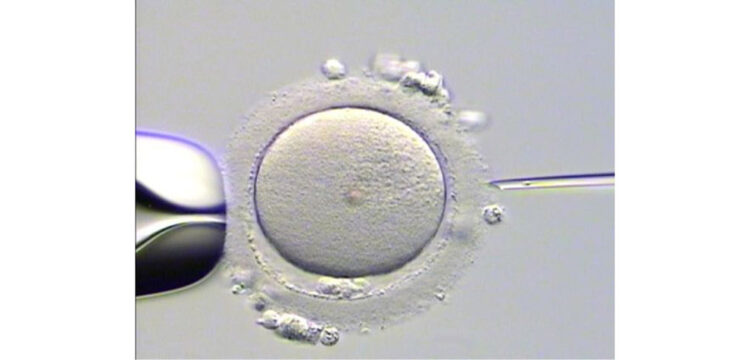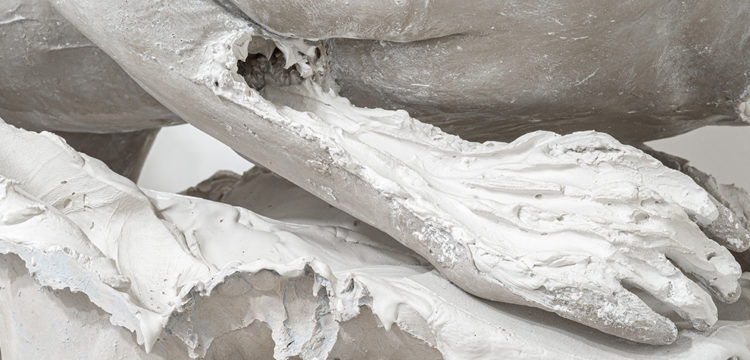Pulse
A journey to the center of the Earth
Vibrations, throbs, jets, pulsations: often imperceptible movements dictate the incessant rhythm of time. They are the resolute movements of an elusive body, trampled and submerged by the layering of a past that is far from over. The apparent static nature of the underground represents a certainty that is as illusory as ever and, indeed, superficial. It sometimes conditions the sensory perception of the surrounding reality. But the resurfacing of a primordial latent, albeit inexhaustible, impulse could become the confrontational opportunity needed to attempt to subvert the dominant narrative, eschewing stifling dystopian visions, so that it really is possible to collectively imagine another tomorrow. After all, the Earth itself generates change.
On March 21, at the Rome headquarters of INGV (Istituto nazionale di Geofisica e di Vulcanologia – National Institute of Geophysics and Volcanology), Liminal State presents PULSE – Power Under Land, Source of Energy. The installation by the duo, formed by artists Gregorio De Luca Comandini and Saverio Villirillo, aims to enhance geothermal energy, or that source of supply achievable through the heat contained in Planet Earth. It is a renewable, alternative and, above all, sustainable form of energy, which can be used in different ways and for different purposes. It found its discovery in Tuscany, in Larderello, in the early twentieth century, where the world’s first geothermal power plant was established.
In the knowledge that different policy choices—such as the withdrawal from international commitments and the drastic reduction of investment in climate change research adopted by several countries—have recently raised concerns, PULSE aims to offer itself as a means to raise attention to sustainability. In addition to affecting collective efforts to deal with the climate crisis, certain decisions can have major repercussions on the socioeconomic conditions of the most vulnerable countries. Therefore, it becomes crucial to foster a research environment that is free from pressure and oriented toward international collaboration, with a view to ensuring a sustainable and inclusive future.
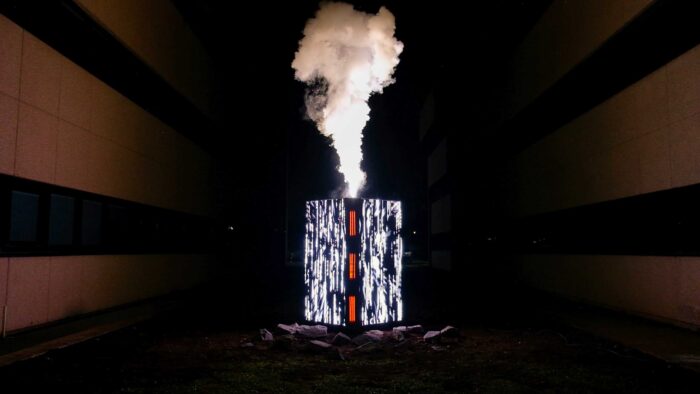
The work consists of a monolith positioned in the center of INGV’s inner courtyard, an exploration device for scientific insights, structured as a website to be enjoyed elsewhere, and a cube of mirrors, with rock samples extracted at depths of more than 1,000 meters inside it, useful for understanding and learning about geothermal systems in the subsurface. The central installation looks like a digital sculpture, made with two LEDwalls separated from each other and two meters high and heating lamps. The activation of the work, scheduled for three times a day at regular intervals, simulates the action of a fumarole-a natural manifestation of volcanic and geothermal areas that occurs through the emanation of steam present near craters or active volcanoes. The breath of heat produced by the fumarolic manifestation attests to the inexorability of time, while the automation of this shared ritual reproduces the systematic nature of biological cycles, as well as the infallible alternation of day and night. PULSE is a journey to the center of the Earth. And the reference to the enigmatic totem pole positioned by Stanley Kubrick in the opening sequence of 2001 A Space Odyssey is quite obvious: it conveys information and symbolizes the very concept of progress, reaffirming the urgency of tangible social change.
Liminal State’s work is a transmedia composition, a heuristic assemblage made of everyday objects, devices and components that can be classified in many ways. It promotes a progressive vision of contemporaneity, implementing a harmonious hybridisation of science and art that is functional to the development of transdisciplinary research, investigation, and experimentation. Conveying certain, often complex messages through different forms of artistic expression means contributing to the process of democratising scientific culture by exploiting the emotional connection established between work and viewer.
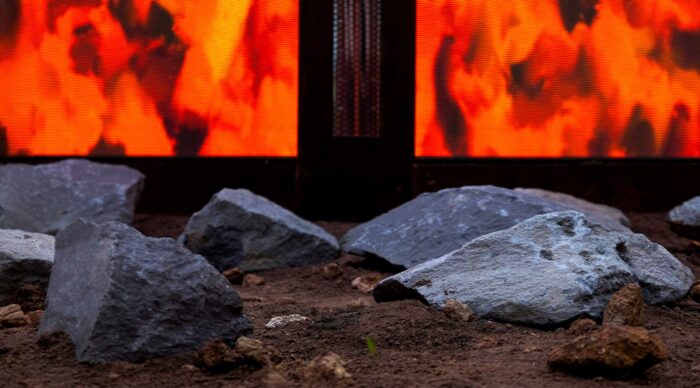
The installation is related to the movement known as Solarpunk, a purposeful utopia whose aim is to contribute in an ethical manner, through technological innovation, science and cultural dissemination, to the effective realisation of a better future, rejecting the oppression of minorities, capitalist individualism and the exploitation of the environment. This work addresses the all too common need to satisfy mostly ephemeral needs, revealing inconsiderate egotistical attitudes towards nature. Between aesthetic storytelling and popularising tool, this interactive monolith questions those perceptive habits resulting from the elaboration of recurring elements in Anthropocentrism. Like an observatory of the future, the non-linearity of the narrative updates the experiential paradigms of new media art and environmental art in an unprecedented way, actively involving the public in the elaboration of conscious operational strategies to contribute to the imagination of scenarios, unfortunately, yet unseen.
Perhaps more than a work of art, PULSE is a warning, or rather, a shared note: the possibility of thinking and building tomorrow is by no means an elitist privilege, but an inalienable right of the universal community. We talked about it with Liminal State.
Jacopo De Blasio: Pulse is a work produced in collaboration with the National Institute of Geophysics and Volcanology (INGV). What do you think is or should be the relationship between scientific research and art? And how can they influence each other?
Liminal State: We believe that scientific research and art are closely related if not, at least in some respects, coincidental. Art focuses on the sensible, that is, the aesthetic and uses this medium to convey certain content, just as science uses Data to disseminate knowledge. In some ways art and science adopt a very similar language, pursuing obviously different goals. In this sense, the meeting with ingv was very important because by a coincidence of goals and visions we were given the opportunity to address a topic of great ethical relevance such as the environmental crisis and, consequently, social justice. Geothermal energy for this can be an answer to doubts and fears.
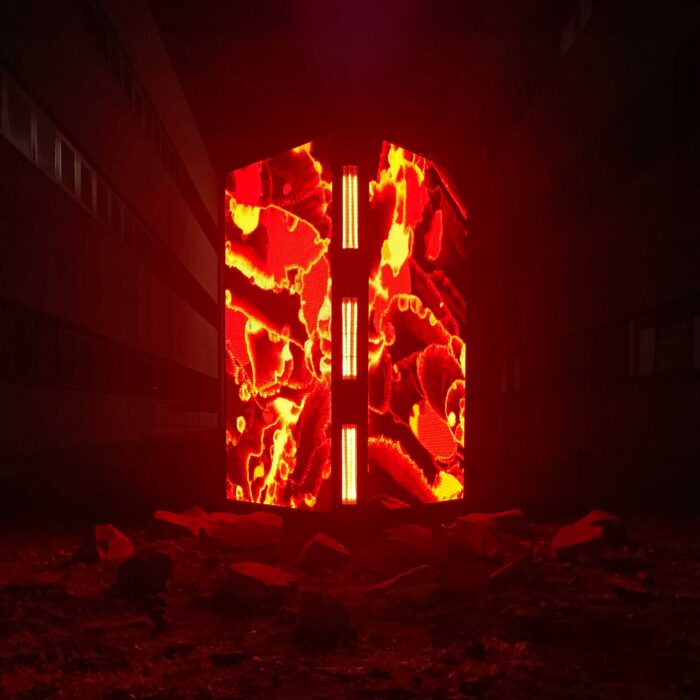
Timothy Morton defines the concept of “hyperobjects” as referring to something that is truly tangible yet invisible, that it is too large to be seen or perceived directly. In your opinion, can art help us visualize and understand issues so large and complex as to seem elusive? Do you believe that contemporary art should or can still have a social, political and, above all, divulgative function, especially regarding environmental issues?
PULSE is a Project that has a social and political as well as popularizing function. In general, our approach to artistic practice is inextricably linked to the analysis of contemporaneity, in all its economic, social and political implications. Artistic research must aim to provide not necessarily answers but at least impulses and visions regarding certain issues. We cannot get away from this aspect. Not least because too often digital or transmedia art seems to forget the social role of art, distracting the viewer captivated by spectacular effects. For us, this is extremely debasing to the mission of art, which is to address contemporary concerns.
PULSE is an artwork that can be traced back to Solarpunk. How did you approach the movement? What are the fundamental points of Solarpunk thought that have influenced your work? And how, in your opinion, could contemporary art and its system really be “sustainable”?
Already in previous editions of Simposio we have brought forward a vision of art that is attentive to critical climatic and social issues. Already with the utopian campsites of the former ENI village of Borca di Cadore (on all the 2022 edition – Non è la fine del mondo) we have tried to give answers to these problems with a resilient and positive spirit rooted in community and diy use of technology and on the use of renewable sources. PULSE certainly fits into this journey, following up on the exhibition held in 2023 in Bergamo, entitled Solarpunk. Regarding the sustainability of art, we think that the Contemporary Art System is strongly linked to the production of added value, that is, speculation, and is nothing but a tool of capitalism to self-generate. It is an instrument of profit and therefore it is not sustainable as it feeds all the absolutely negative dynamics of contemporary capitalism. If, on the other hand, we step outside the Art System and think about art practice even more generally, we too follow with interest some artists, such as Joanie lemercier, who propose works that involve the sometimes-expensive use of renewable technologies and energy both to address certain social issues and to develop less impactful solutions that use sustainable sources. In this case, for the implementation of PULSE, we had the client enter a 100% renewable energy contract.
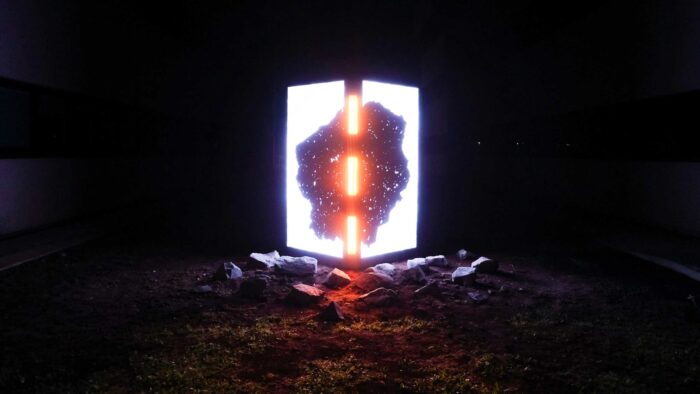
Pulse is a permanent installation, placed among the corridors of the INGV in Rome, in the inner courtyard of the building. How might the work affect a liminal space such as this place of transit? And what do you think should be the role of the public in the enjoyment of the work itself?
For the realization of PULSE we had to deal with a place that usually hosts popular exhibits, more canonical let’s say, while thanks to the courage of the researchers who proposed this project to us we were able to install a work that presents a predominantly aesthetic and perceptive language. The work is supported by a web platform and a screen inside the building on which to explore the issues addressed by the artwork. So it was a break from the usual mode of INGV, because we adopted a more artistic and abstract language than usual.
Between digital production, environmental art, and transmedia, which artists and works have influenced the making of Pulse and your research more generally?
Sticking to PULSE, certainly one of the references is Joanie Lemercier, as well as Boris Acket is, more in general, one of the artists who has inspired us over time. Ned Kahn is also another artist and architect who has influenced us, especially with his material installations that interact with natural elements. These may be some of the references that we brought through the natural element included in the work which is the fumarole.
A statement to conclude: what does the concept of progress mean for Liminal State?
The very theme of the liminal state for us means moving along the thresholds of perception and places that can be altered and modified through new media, transmedia and technology. We carry this discourse forward as a liminal rite of accretion both internally, as knowledge, and as overcoming the self, to enter a state of otherness and transcend the boundaries of reality. In general, regarding the concept of progress, we are not so much fascinated by scientific technical progress or technological innovation. But we believe that new media and technology should interact with simple and natural, even mundane, physical, and perceptual elements, which are sometimes the most effective in generating a feeling of wonder. So the aim of progress is not so much technical development but rather a search for meaning in everyday practices, that is, as we said earlier, using these languages to address critical contemporary issues and stimulate new approaches and new visions of reality.


